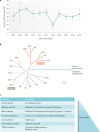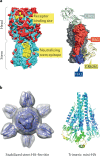Next-generation influenza vaccines: opportunities and challenges
- PMID: 32060419
- PMCID: PMC7223957
- DOI: 10.1038/s41573-019-0056-x
Next-generation influenza vaccines: opportunities and challenges
Erratum in
-
Author Correction: Next-generation influenza vaccines: opportunities and challenges.Nat Rev Drug Discov. 2020 Jun;19(6):427. doi: 10.1038/s41573-020-0066-8. Nat Rev Drug Discov. 2020. PMID: 32494049 Free PMC article.
Abstract
Seasonal influenza vaccines lack efficacy against drifted or pandemic influenza strains. Developing improved vaccines that elicit broader immunity remains a public health priority. Immune responses to current vaccines focus on the haemagglutinin head domain, whereas next-generation vaccines target less variable virus structures, including the haemagglutinin stem. Strategies employed to improve vaccine efficacy involve using structure-based design and nanoparticle display to optimize the antigenicity and immunogenicity of target antigens; increasing the antigen dose; using novel adjuvants; stimulating cellular immunity; and targeting other viral proteins, including neuraminidase, matrix protein 2 or nucleoprotein. Improved understanding of influenza antigen structure and immunobiology is advancing novel vaccine candidates into human trials.
Conflict of interest statement
C.-J.W., J.S., and G.J.N. are employees and stock owners of Sanofi, whose subsidiary Sanofi-Pasteur is a major influenza vaccine producer and has issued patents and pending filed patent applications on various influenza vaccine technologies. C.-J.W and G.J.N. are inventors of gene-based and nanoparticle-based influenza vaccines that have been filed by either Sanofi or the US government. J.R.M. and B.S.G. are employees of the US government, which has issued patents and filed patent applications on various vaccines including ferritin nanoparticle-based influenza vaccines mentioned in this article. The other authors declare no competing interests.
Figures



References
-
- Centers for Disease Control and Prevention. Seasonal influenza vaccine effectiveness, 2004–2018https://www.cdc.gov/flu/vaccines-work/past-seasons-estimates (CDC, 2019).
Publication types
LinkOut - more resources
Full Text Sources
Other Literature Sources

